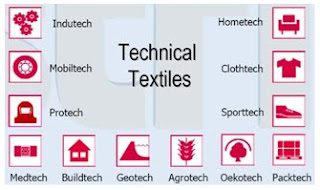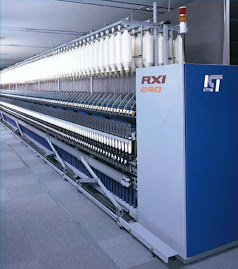The Textile Institute defines technical textiles as the 'textile materials and products manufactured primarily for their technical and performance properties rather than their aesthetic or decorative characteristics '.
An exceptional feature of technical textiles is the use of innumerable varities of raw materials, processes, product and application for their production. Some of the materials used for making technical textile such as Metal, like steel; Minerals, like asbestos and glass; Synthetic fibre polymers, like PES, PA, PAN, PP etc. Regenerated fibres like rayon fibre and acetate fibre. Natural fibres like cotton fibre, like cotton fibre, wool fibre etc.
2. Technical Textiles
Technical textiles are textile materials manufactured mainly for their technical performance and functional properties. Technical textiles in various contexts are often referred to as performance textiles or functional textiles or engineered textiles or high-tech textiles.
2.1 Other terms used:
2. Functional textile
3. Performance textile
4. Engineering textile
5. Invisible textile
6. high-tech textile
2.2 Technical textiles are usually applied in the following 12 main areas
- Agrotech comprises of agriculture, horticulture, aquaculture and forestry
- Buildtech comprises of building and construction
- Clothtech comprises of technical components of footwear and clothing.
- Geotech comprises of technical components of geotextiles and civil engineering
- Hometech comprises of technical components of furniture, household textiles and floor coverings.
- Indutech comprises of filtration, conveying, cleaning and other industrial uses
- Medtech comprises of medical field and hygiene
- Mobiltech comprises of automobiles, shipping, railways and aerospace
- Oekotech comprises of environmental protection
- Packtech comprises of packaging
- Protech comprises of personal and property protection
- Sporttech comprises of sports and leisure


Some fields of application for technical textiles
| SECTOR | EXAMPLES | MARKETS |
| Earthworks | Linings, netting, insulation, artificial grass ("geotextiles") | Construction companies for roads, water engineering, soil stabilisation, tunnels and other earthworks |
| Construction | Insulation and roofing materials ("building textiles") | Building firms, architects |
| Agriculture | Sun protection for greenhouses, fishing nets ("agrotextiles") | Farming, horticulture and fishing |
| Transport | Car mats and lining, airbags, fire resistant seat covers and carpets, safety belts | Producers of cars, aeroplanes, boats |
| Medical and healthcare | Bandages, medical corsetry
| Hospitals, nursing homes, households |
| Protection | Safety nets, ribbons and tapes, fire resistant clothing
| Industry, public procurement, households |
| Packaging | Twine and cordage, sacks and bags, tarpaulins ("packing textiles") | Industry, distribution, households |
| Military and public services | Fire service equipment, bullet-proof jackets, army tents, parachutes, extinguishing blankets, tubes | Military/security, forestry, offshore oil industry |
| Specialised clothing | Sports, skiing and leisure | Active sports, mountaineering, households |
| Communications | Optical fibres, image conductor cables | Communication sector |
| Industry | Filters, drive and conveyer belts, abrasive belts | Engineering, machinery, chemicals, plastics, mining, energy, etc. |
| Furnishing | Interlaid scrims, braiding, shower curtains, umbrellas, parasols, deck chairs, textile wall papers | Decoration firms, households |
1. Technical Textile products:
Within the composites industry, woven, knitted braided, non woven(link) and wound reinforcements produced from glass, carbon fiber and organic polymer materials like aramids are presently accepted as technical textile products.
2. Technical Textile fiber:
Almost 90 % of the fibers(link to textile fabric) utilized to make technical textiles belong to the category of conventional fibers and the fibers specially developed to specifically use in technical textiles are not only expensive but often have limited applications.
3. Conclusion:
Technical textile is more importance to developed our export economy. Bangladesh is leg behind in technical textiles precuts as neither the government nor the textile industry has made any serious efforts towards synchronizing textile products with emerging needs of our world markets by developing high value added products. our government and the textile industry keep their focus on conventional textiles ,ignoring technical textile and knowledge –based products.
4. Reference:



